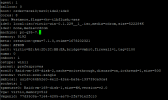We are passing our cloud infrastructure from ESXI to Proxmox, we have found that the windows server 2022 machines are very slow, they are used for Terminal Server and they use their software which consumes SQL server, I have looked to activate the "disable" checks and "SSD Emulation" of the disk, which is mounted in scsi, (the disks of the physical machine are SSD), and we have the cpu in kvm64, I don't know what else we can modify to improve performance, could you help me?
agent: 1
boot: order=scsi0;net0;ide2;ide0
cores: 10
ide0: none,media=cdrom
ide2: none,media=cdrom
machine: pc-q35-7.1
memory: 8196
meta: creation-qemu=7.1.0,ctime=1678202321
name: XXXXXXX
net0: virtio=36:EE:81:30:A3:85,bridge=vmbr0,firewall=1,tag=2100
net1: e1000=06:A3:43:11:9F:2D,bridge=vmbr0,firewall=1,tag=1743
numa: 0
onboot: 1
ostype: win11
scsi0: Raid:vm-162-disk-0,discard=on,iothread=1,size=50G,ssd=1
scsihw: virtio-scsi-single
smbios1: uuid=990f6244-9b03-4fd3-8bda-11e788db3692
sockets: 1
tpmstate0: Raid:vm-162-disk-1,size=4M,version=v2.0
vmgenid: a7ff26f8-f406-4217-8129-505e73b93db1
agent: 1
boot: order=scsi0;net0;ide2;ide0
cores: 10
ide0: none,media=cdrom
ide2: none,media=cdrom
machine: pc-q35-7.1
memory: 8196
meta: creation-qemu=7.1.0,ctime=1678202321
name: XXXXXXX
net0: virtio=36:EE:81:30:A3:85,bridge=vmbr0,firewall=1,tag=2100
net1: e1000=06:A3:43:11:9F:2D,bridge=vmbr0,firewall=1,tag=1743
numa: 0
onboot: 1
ostype: win11
scsi0: Raid:vm-162-disk-0,discard=on,iothread=1,size=50G,ssd=1
scsihw: virtio-scsi-single
smbios1: uuid=990f6244-9b03-4fd3-8bda-11e788db3692
sockets: 1
tpmstate0: Raid:vm-162-disk-1,size=4M,version=v2.0
vmgenid: a7ff26f8-f406-4217-8129-505e73b93db1


